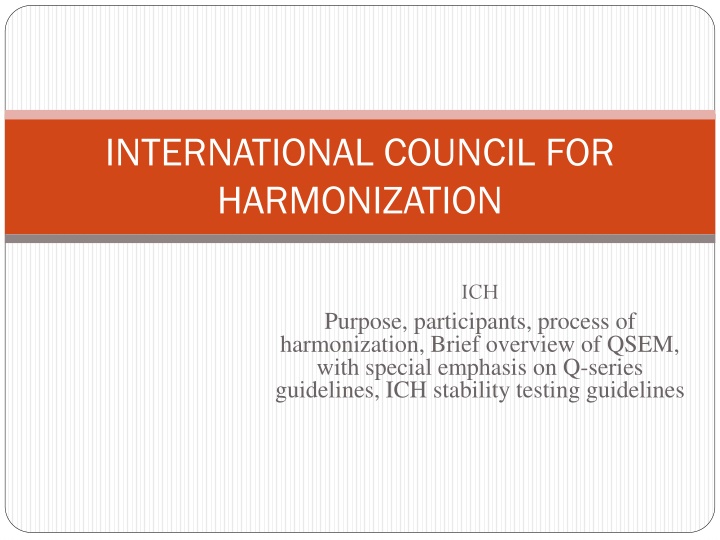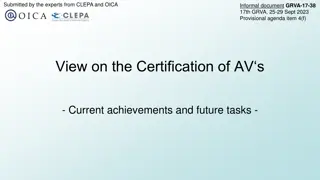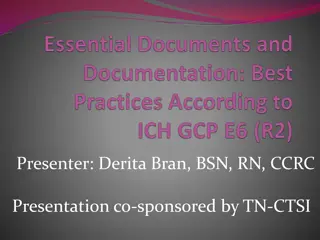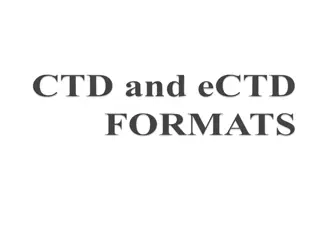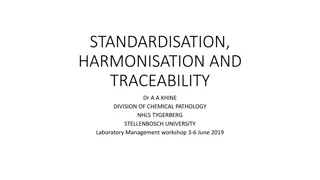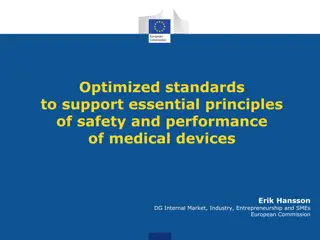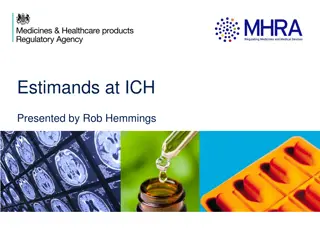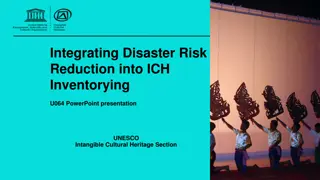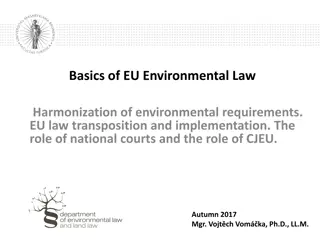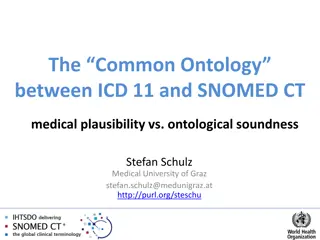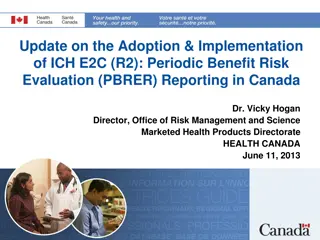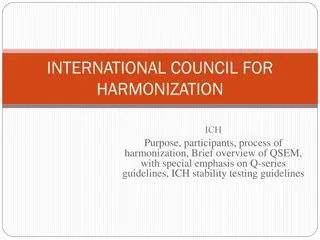International Council for Harmonization (ICH): Purpose and Process Overview
The International Council for Harmonization (ICH) aims to harmonize technical requirements for pharmaceutical products globally, ensuring safe and effective medicines. Learn about the purpose, participants, and harmonization process, including the role of Q-series guidelines and stability testing guidelines.
Download Presentation

Please find below an Image/Link to download the presentation.
The content on the website is provided AS IS for your information and personal use only. It may not be sold, licensed, or shared on other websites without obtaining consent from the author.If you encounter any issues during the download, it is possible that the publisher has removed the file from their server.
You are allowed to download the files provided on this website for personal or commercial use, subject to the condition that they are used lawfully. All files are the property of their respective owners.
The content on the website is provided AS IS for your information and personal use only. It may not be sold, licensed, or shared on other websites without obtaining consent from the author.
E N D
Presentation Transcript
INTERNATIONAL COUNCIL FOR HARMONIZATION ICH Purpose, participants, process of harmonization, Brief overview of QSEM, with special emphasis on Q-series guidelines, ICH stability testing guidelines
ICH Guidelines : Inception 1990 International council for harmonization, earlier Conference Technical requirement for pharmaceuticals for human use Step to bring regulatory authorities & Pharmaceutical Industry to discuss scientific & technical aspects of drug registration Mission of ICH: To achieve greater harmonization worldwide to ensure safe, effective, high quality medicines are developed/registered in most resource & effective manner
PURPOSE OF ICH GUIDELINES Registration & maintenance of Pharmaceutical product registration To have dialogues on scientific issues b/w regulatory authorities & Pharmaceutical Industry for harmonization of technical requirements of Pharm. product Contribute to public health Monitor & update harmonized technical requirements, leads to mutual acceptance of R& D data To avoid various future requirements through harmonization of selected topics Facilitate adoption of new or improved technical R&D approaches, replacing or updating current practices
Implementation & integration of common standards by dissemination of the communication of information about and coordination of training on harmonized guidelines & their use To develop policy for ICH medical dictionary for regulatory activities terminology (MedDRA)- share regulatory information internationally for medicinal products Process of harmonization: 4 categories Formal ICH procedure Q & A procedure Revision procedure Maintenance procedure
Concept paper & business plan required New Topic for harmonization of ICH Formal ICH Procedure Clarification needed for existing ICH Concept paper required Business plan required Q & A procedure Content of an existing ICH out of date or no longer valid Concept paper required Revision Procedure New information to be added to an existing ICH G Proposal/concept paper required for Q3C maintenance. No concept paper required for M2 recommendations maintenance Change to be made either toQ3C guidelines or M2 recommendations Maintenance Procedure Business plan outlines includes costs & benefits of harmonizing topic proposed by concept paper
4 Categories of ICH topics Quality Guidelines Safety Guidelines To uncover potential risk like carcinogenicity, genotoxicity, reprotoxicity Includes Stability studies, thresholds for impurities testing, flexible approach for pharm. quality based GMP risk management Efficacy Guidelines Multidisciplinary Guidelines Includes ICH medical terminology MedDRA, common tech. document CTD, development of electronic standards for transfer of regulatory information ESTRI Concerned with design, conduct, safety & reporting of clinical trials Novel medicines derived from biotech processes, use of pharmacogenetics genomic tech. to produce targeted medicines
BRIEF OVERVIEW OF QSEM Q series: Quality Guidelines are Q1A-Q1F: Stability Q2- Analytical validation Q3A-Q3D Impurities Q4A-Q4B- Pharmacopoeias Q5A-Q5E- Quality of Biotechnological products Q-6A-Q6B- Specifications Q7 GMP Q8 Pharmaceutical Development Q9 Quality risk management Q10- Pharmaceutical Quality System Q11 Development & Manufacture of Drug substances Q12 Life cycle Management Q13 Continuous Manufacturing of Drug substances & drug products Q14 Analytical Procedure Development
Safety Guidelines S Series S1A - S1C- Carcinogenicity studies S3A-S3B- Toxicokinetics & Pharmacokinetics S4- Toxicity testing S5 Reproductive testing S6 Biotechnological Product S7A-S7B- Pharmacology studies S8- Immunotoxicology studies S9 Non clinical evaluation of anticancer pharmaceuticals S10 Photosafety S11 Non clinical pediatric safety
Efficacy Guidelines E SERIES E1- Clinical safety for drugs used in long term treatment E2A-E2F- Pharmacovigilance E3 Clinical study reports E4- Dose response studies E5 Ethnic factors E6 Good clinical practice E7 Clinical Trials in Geriatric population E8 General considerations for clinical trials E9 Statistical Principles for clinical Trials E10 Choice of control group in clinical trials
Efficacy Guidelines E SERIES Efficacy Guidelines E SERIES E11 E11A Clinical Trials in pediatric population E12 Clinical Evaluation by Therapeutic category E14 Clinical Evaluation of QT (Wave, effect on Heart) E15 Definitions in Pharmacogenetics/ Pharmacogenomics E16 Qualification of Genomic Biomarkers E17 Multi Regional Clinical Trials E18 Genomic Sampling E19 Safety DATA Collection
Multidisciplinary guidelines M series M1 MedDRA Terminology M2 Electronic standards M3 Non clinical safety studies M4 Common Technical Document M5 Data Elements and standards for drug dictionaries M6 Gene Therapy M7 Mutagenic impurities M8 Electronic common Technical document (eCTD) M9 Biopharmaceutics classification based biowaivers M10 Bioanalytical Method development M11 Clinical electronic structured harmonized protocol (CeSHarP)
Special emphasis on Q series Q1 A R2 Stability testing of new drug substances & products (NDSP) SEP. 1994 Rev. 2001 Feb 2003 Harmonize Intermediate storage condition for Zone 1 & II with long term condition for Zone III & IV recommended in Q1F (Stability data package for reg. applications in climatic zones III & IV) Storage conditions Climate zones Countries Def Temp. Humidity I Japan, UK, North Eur. Canada, Russia, USA etc Japan South Eur USA etc Temperate 21 C 45% II Sub Trop Mediter. Hot dry Tropical 25 C 60% III IV Iran Iraq Sudan etc Brazil Ghana Indonesia Nicaragua Philippines India Pak Bangladesh 30 C 35% 30 C 70%
Variety of Env. factors- affecting quality of drug Stress testing: degradation products, intrinsic stability of molecule Includes effect of temp in 10 C increment 50, 60 etc, humidity 75% RH or greater, oxidation, photolysis Susceptibility to hydrolysis over wide pH range in solution/ suspension Photostability testing described in Q1B Frequency of testing: For long term studies: at least 12 months- every 3 month over first yr and every 6 months over second yr & annually thereafter At accelerated storage condition minimum three time points including initial and final time points (0,6,9,12 months) from a 12 month study
Storage conditions Test the thermal stability, sensitivity to moisture During storage, shipment, subsequent use General case: 3 primary batches- 12 month duration Long term: 12 M- 25 C 2 C/60%RH 5% RH or 30 C 2 C/65%RH 5% RH Intermediate: 6 months 30 C 2 C/65%RH 5% RH Accelerated: 40 C 2 C/75%RH 5% RH If long term studies show significant changes during 6 months- accelerated & intermediate studies to be done
Storage conditions Storage in refrigerator Long term: 5 C 3 C 12 months Accelerated: 5 C 2 C/60% 5 RH 6 months If significant change: b/w 3-6 months- accelerated storage testing to be done In a freezer: Long term - 20 C 5 C 12 months For below -20 C treat on case by case basis Evaluation: if batch to batch variation is small, combine data in one overall estimate Statement/ Labeling Storage statement on label- based on stability evaluation
